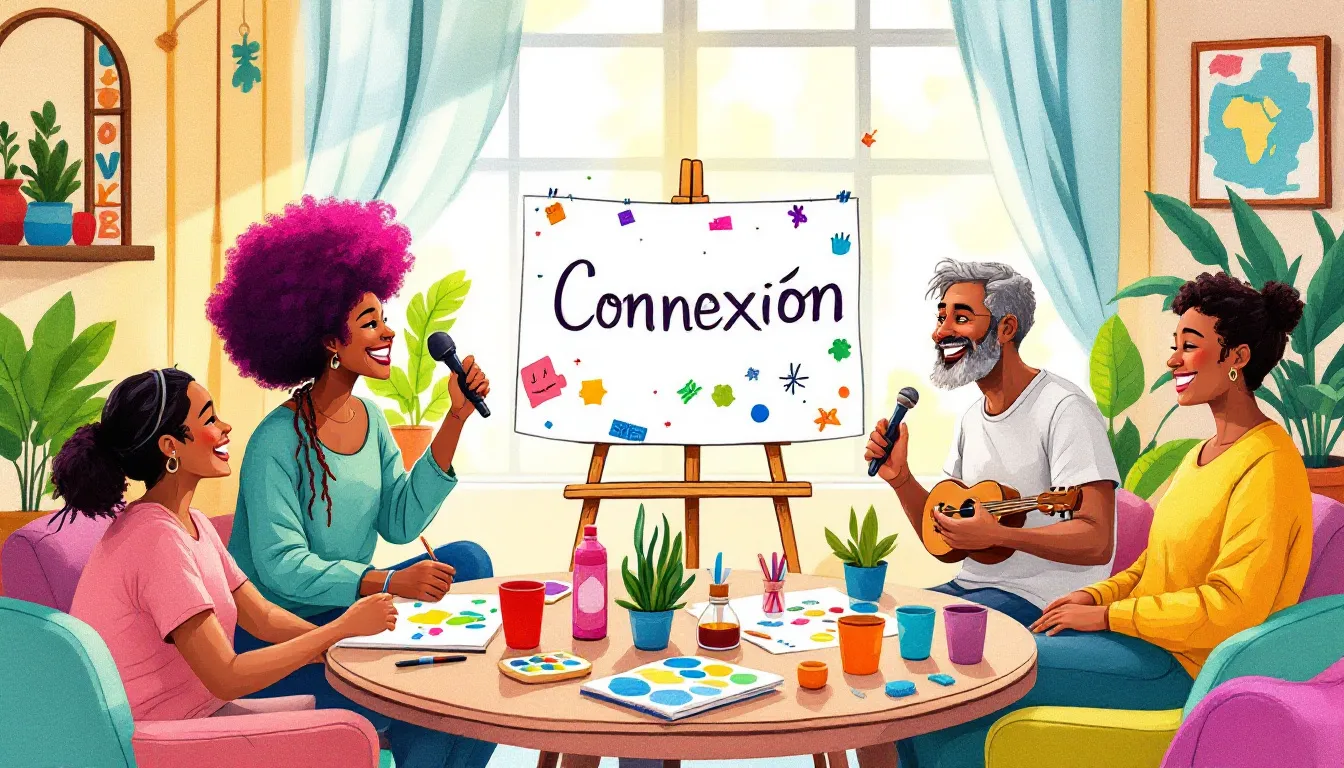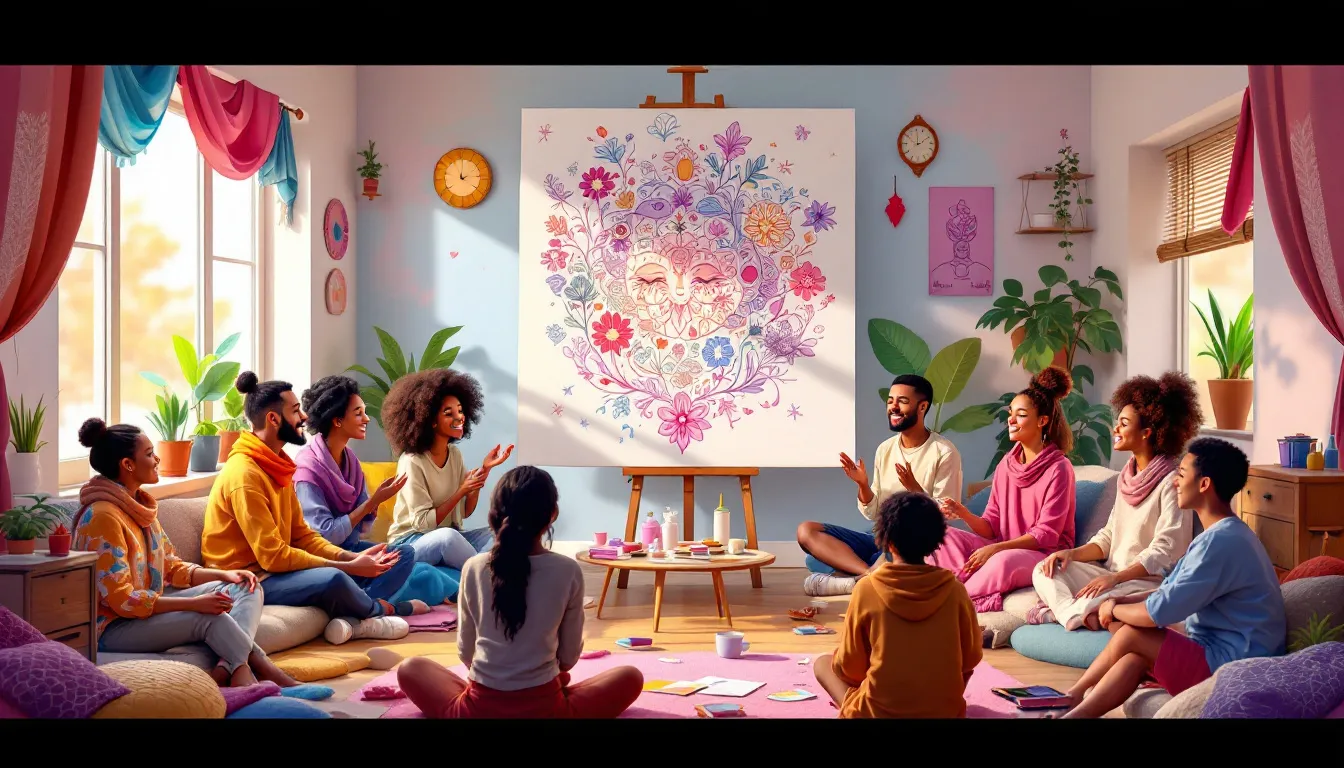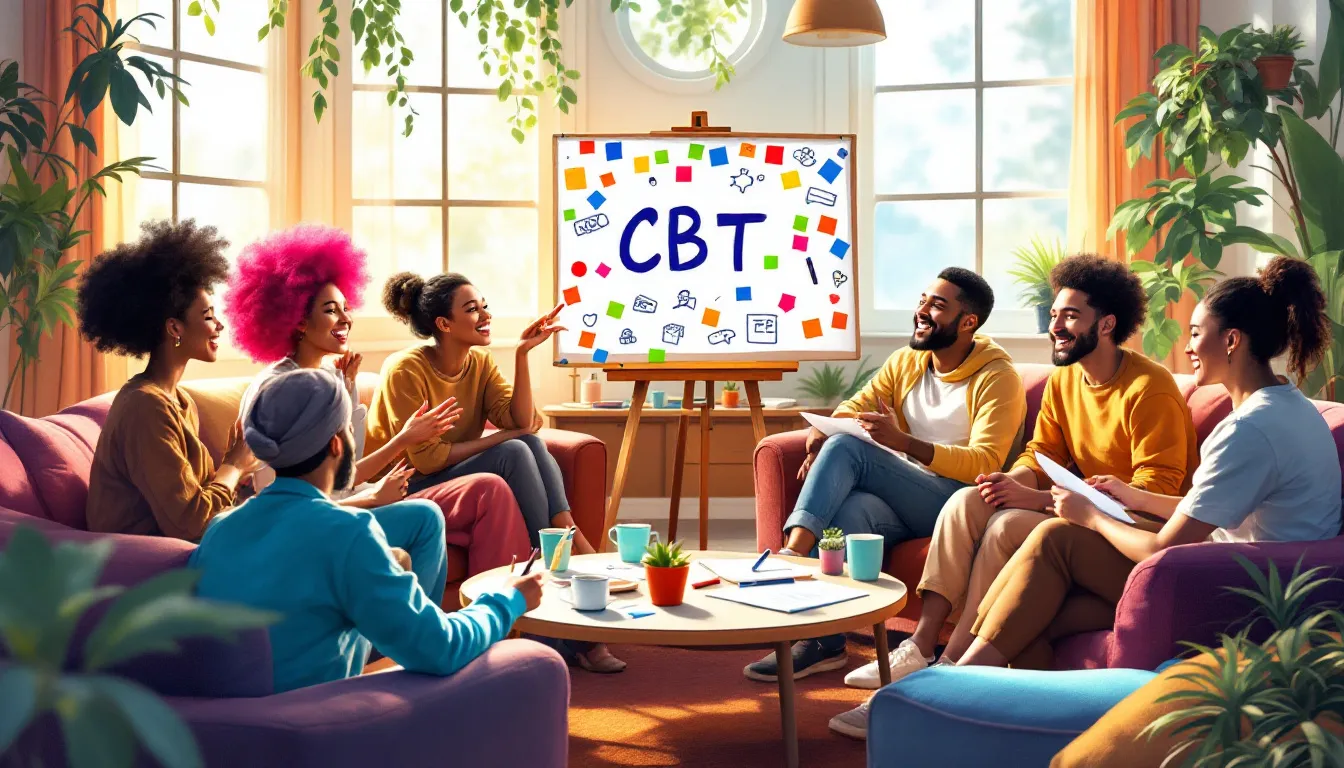Need effective group therapy activities? This guide provides 25 proven activities to help participants connect and grow. Group therapy activities are essential for fostering trust, enhancing communication, and supporting mental health. Read on to discover the best options for your sessions.
Key Takeaways
-
Group therapy fosters personal growth and resilience by facilitating connections and shared experiences among participants.
-
Customized activities and clear ground rules enhance participation and create a supportive atmosphere, crucial for effective group therapy sessions.
-
Incorporating trust-building, emotional expression, and positive psychology activities promotes emotional resilience and a positive mindset among group members.
Understanding Group Therapy
Group therapy is a therapeutic approach where one or more therapists work with a group of individuals to facilitate healing and shared experiences. The purpose of these sessions is to connect individuals, share experiences, and develop essential skills. The support and mutual understanding found in group psychotherapy can significantly improve mental health, fostering personal growth and resilience.
Research supports the effectiveness of group therapy in treating various mental health conditions, especially depression. Participants often find that being part of a mental health group therapy helps them enhance their social skills and cope better with complex life events, relationship difficulties, addiction, or other mental health issues. Specialized techniques are employed to address specific concerns, promoting personal growth and healing.
Key Components of Group Therapy Sessions
Group therapy sessions offer the opportunity for participants to connect with others, gain new perspectives, and learn from their peers in a group session. Facilitators guide discussions and create a safe atmosphere, ensuring meaningful participant experiences. A trained facilitator, or group leader, leads these sessions, possessing the skills necessary to manage interactions effectively.
Clear ground rules and effective management of group dynamics ensure successful sessions. Ground rules such as confidentiality and respect help create a supportive environment, while managing group dynamics ensures balanced participation and addresses any conflicts that may arise.
Customizing activities to the group’s needs and regularly evaluating their effectiveness can maximize the impact of the therapy.
Establishing Ground Rules
Ground rules in group therapy promote trust, confidentiality, and productive interactions in group settings. Establishing these rules creates a safe and respectful space for all group members. The group leader should involve participants in formulating these rules to foster a greater commitment to adhering to them.
This approach ensures everyone feels valued and understood, fostering effective group therapy.
Managing Group Dynamics
Facilitators must encourage equal participation, ensuring all group members have the opportunity to share their thoughts and feelings. Neutrality helps in effectively mediating conflicts within the group. Facilitators should also be aware of their own biases and triggers to manage group dynamics effectively.
Engaging in activities like “Two Truths and a Lie” can promote closer bonds, making participants more comfortable in discussions.
Ice Breaker Activities for Building Connections
Icebreaker activities are designed to create a relaxed atmosphere, encourage expression, promote communication, and build trust among participants. Group activities help participants remain focused and facilitate stronger bonds.
Starting with icebreakers and then progressing to more demanding activities is a recommended approach to facilitate comfort and engagement in group therapy.
The Name Game
The Name Game encourages familiarity and connection among group members by inviting them to share something unique about themselves. Participants take turns stating their name along with a unique personal detail.
This engaging activity helps group members and other group members introduce themselves, fostering a sense of belonging and setting the stage for deeper interactions.
Two Truths and a Lie
The game “Two Truths and a Lie” is a fun activity that encourages participants to share statements about themselves. It fosters familiarity by prompting members to share personal statements. This engaging activity enhances social skills through fun interaction, making participants more comfortable sharing in future sessions.
Trust-Building Exercises
Trust-building exercises are essential in group therapy as they create a safe environment for sharing experiences and foster open communication. Activities like the Human Knot encourage teamwork and problem-solving, helping group members develop essential skills while building trust. These exercises not only promote trust but also enhance communication skills and emotional resilience through shared experiences.
Another effective exercise is the Blindfolded Trust Walk, where one participant is blindfolded and must rely on verbal guidance from their partner to navigate through a designated course. This activity strengthens trust and empathy, as participants learn to depend on each other for support and guidance.
Through these trust-building exercises, group members can develop deeper connections and a stronger sense of community.
Human Knot
The main objective of the Human Knot activity is to encourage teamwork and problem-solving. Participants stand in a circle, reach out to hold hands with others across from them, and then work together to untangle themselves without letting go.
This activity fosters cooperation and communication, essential skills for effective group therapy.
Blindfolded Trust Walk
In the Blindfolded Trust Walk, one participant is blindfolded and must rely on verbal guidance from their partner to navigate through a designated course. This exercise strengthens trust and empathy, as participants learn to depend on each other for support and guidance.
It’s a powerful way to build trust and enhance communication within the group.
Emotional Expression Activities
Emotional expression activities in group therapy help participants explore and communicate their feelings, increasing self-awareness and enhancing emotional regulation. Art therapy, for example, allows participants to create visual representations of their feelings, aiding in emotional processing. Visual journals, which can include drawings, paintings, and collages alongside written reflections, are another effective tool for emotional expression.
Expressive journaling helps clients articulate complex emotions and promotes emotional healing. Group members can use themed prompts to guide their journal entries, enhancing focus and reflection. These activities not only foster self-expression but also create a supportive environment where participants feel safe sharing their emotional experiences.
Draw Your Mood
The “Draw Your Mood” activity encourages participants to visualize their feelings, fostering a deeper understanding of their emotional states. Participants can use a virtual whiteboard to illustrate their feelings, allowing for a combination of creativity and emotional sharing.
After drawing, a group discussion promotes self-awareness and connects participants through shared emotional experiences.
Emotion Wheel
The Emotion Wheel is a visual tool that helps individuals identify, understand, and express their emotions more clearly. Group members engage with the Emotion Wheel by selecting emotions that resonate with their current feelings, prompting deeper discussions.
Utilizing the Emotion Wheel enhances emotional regulation skills by allowing individuals to recognize and articulate their feelings in a constructive manner.
Cognitive Behavioral Therapy (CBT) Activities
Cognitive Behavioral Therapy (CBT) is a type of psychotherapy. It assists individuals in understanding and changing their thought patterns and behaviors. Combining cognitive-behavioral techniques with group support allows participants to share experiences and insights, enhancing the therapy process. CBT activities typically emphasize identifying triggers and developing coping strategies. Additionally, they encourage building a support network.
Recognizing personal strengths can facilitate greater self-awareness and empower individuals to leverage their unique capabilities in various situations. Shifting perspectives from weaknesses to strengths through exploration can significantly enhance resilience and motivation.
These structured activities help participants learn and practice new coping skills, improving their overall mental health.
Thought Replacement
Cognitive restructuring entails questioning irrational thoughts. It also includes substituting these thoughts with more balanced alternatives. The CBT activity includes identifying negative thoughts. It also involves questioning and reframing them. Group members can use the thought replacement technique by writing down negative thoughts and passing them around for positive perspectives.
This exercise helps participants replace negative thoughts with positive alternatives, promoting better mental health.
Behavioral Activation
Behavioral activation in CBT involves identifying and engaging in positive behaviors to improve mood. Activity scheduling counteracts withdrawal and inactivity, helping individuals with depression to engage more in life.
Group members work together to brainstorm enjoyable activities and create action plans for group development, encouraging participants to engage in positive behaviors that enhance their well-being.
Mindfulness Exercises
Adults can benefit from mindfulness exercises, as they help in staying present. Additionally, these exercises are effective in reducing stress. Activities included in mindfulness exercises are guided meditations, body scans, and breathing exercises. These practices are effective for cultivating mindfulness by encouraging participants to engage with their sensory experiences. Coloring mandalas, for example, can serve as a meditative practice, promoting relaxation and focus.
Guided sessions of muscle relaxation can enhance participants’ awareness of body sensations and promote mental relaxation. This technique not only helps in relaxation but also increases awareness of bodily sensations and promotes mindfulness.
By incorporating mindfulness exercises into group therapy sessions, participants can develop coping strategies and enhance their emotional regulation skills.
Body Scan Meditation
The body scan exercise enhances self-awareness and emotional regulation. This meditation technique encourages participants to focus on sensations in different body parts, promoting relaxation and heightened self-awareness.
Facilitators encourage sharing among participants to reflect on their experiences after the body scan exercise, fostering a deeper understanding of their physical and emotional states.
Five Senses Exercise
The five senses exercise grounds individuals in the present moment, helping manage anxiety or stress. Participants identify five things to see, four to feel, three to hear, two to smell, and one to taste. This exercise helps participants engage with their sensory experiences, promoting mindfulness and reducing anxiety.
Art Therapy Techniques
Art therapy is a powerful tool for self-expression in group therapy, facilitating emotional exploration through creative activities. Drawing activities, like illustrating one’s inner child and listing their emotional needs, encourage participants to reflect on their feelings and experiences. Another drawing exercise involves illustrating nature’s survival in harsh environments, promoting resilience and emotional processing.
Using collage-making allows participants to combine various materials to express their feelings and creativity, enriching the emotional exploration process. These techniques provide a non-verbal outlet for emotions, making them accessible for discussion and reflection in a group setting. Art therapy techniques significantly enhance emotional regulation and self-awareness.
Expressive Journal Writing
Expressive journal writing involves group members writing about their thoughts and feelings, which encourages self-expression and reflection. This type of writing can combine words, drawings, sketches, and collages to represent emotions.
By incorporating expressive journaling into group therapy sessions, participants can better articulate and process their emotions.
Mandala Coloring
Mandala coloring is a calming activity where participants engage in coloring intricate designs, helping them express feelings non-verbally. This activity aids in stress relief by providing a creative outlet and distracting participants from everyday worries.
Mandala coloring promotes mindfulness by focusing participants on coloring and the present moment.
Positive Psychology Activities
Positive psychology activities aim to improve mental well-being by focusing on strengths, virtues, and positive aspects of life. These exercises significantly improve mental health by reinforcing optimistic thinking. Trust-building activities create an environment that encourages sharing and support among group members, significantly enhancing communication skills and teamwork.
Activities such as body scan meditation can improve self-acceptance and lower stress hormone levels. Positive psychology activities improve overall mental wellbeing and resilience among participants.
These activities promote a supportive environment where participants can thrive and grow.
Gratitude Journaling
Gratitude journaling encourages individuals to reflect on the positive aspects of their lives. Writing about things one is grateful for can improve overall mental well-being and resilience. A gratitude journal helps individuals identify and focus on positive experiences, fostering a positive mindset.
Activities such as daily listing of three things one is grateful for can enhance the effectiveness of gratitude journaling.
Strengths Exploration
Identifying personal strengths allows participants to recognize their unique qualities, boosting self-esteem and fostering a positive self-image. This activity encourages participants to reflect on their strengths, leading to greater self-awareness and promote personal growth.
Strengths exploration can significantly enhance resilience and motivation by focusing on the positive aspects of oneself.
Stress Management Techniques
Group activities improve mental health, relieve stress, reduce anxiety, and increase self-awareness. Emotional expression activities can significantly enhance participants’ emotional resilience and coping strategies. Practicing gratitude through journaling can enhance emotional well-being and reduce feelings of anxiety and depression. Keeping a gratitude journal can significantly boost happiness and emotional resilience by encouraging individuals to reflect on positive experiences.
Mindfulness practices in group therapy help individuals enhance their awareness of the present moment and cultivate emotional regulation. Practicing techniques such as the five senses exercise can help individuals disrupt patterns of anxiety and enhance grounding in the moment.
Behavioral activation sessions encourage group members to reflect on how engaging in specific therapy activities can lead to improved mental health outcomes.
Breathing Exercises
Breathing exercises help participants focus on their breath to promote relaxation and reduce anxiety within group therapy sessions. Diaphragmatic breathing encourages participants to inhale deeply, expanding the stomach before the lungs, fostering a calming effect. Mindful breathing techniques, like counting breaths, help individuals maintain focus and reduce anxiety during group sessions.
Simple techniques like deep breathing can be easily incorporated into group sessions to enhance relaxation.
Progressive Muscle Relaxation
Progressive muscle relaxation teaches individuals to tense and then relax muscle groups, aiding in stress reduction and awareness of physical sensations. This technique involves systematically tensing and relaxing different muscle groups to alleviate physical tension and promote relaxation.
Incorporating progressive muscle relaxation into group therapy sessions can enhance participants’ awareness of physical tension and promote a state of calm.
Closing Session Activities
Concluding activities in group therapy provide a structured way for members to reflect on their experiences during the session. These activities enhance group cohesion, solidifying bonds among members as they engage in meaningful reflections together. Ultimately, these activities encourage members to consider their personal growth and the themes discussed, fostering ongoing development.
Listening to chosen songs together, for example, can connect group members emotionally and prompt discussions about their significance. Such activities not only provide closure but also reinforce the learnings and emotional connections made during the session.
Group Reflection
Reflection is a vital part of group therapy that allows members to consolidate their experiences and learnings. Engaging in reflection activities promotes personal growth and emotional understanding among group members.
Incorporating activities like the Positive Affirmations Circle enhances the sharing of insights and strengthens group cohesion.
Positive Affirmations Circle
In a positive affirmations circle, participants take turns expressing positive statements about themselves, fostering self-esteem and mutual support within the group. Sharing affirmations fosters a supportive environment and strengthens group cohesion.
Participants may benefit from a structured format to share their affirmations, enhancing the overall effectiveness of the activity.
Summary
Group therapy offers a unique opportunity for individuals to connect, share, and grow together. From icebreakers that build initial rapport to mindfulness exercises that enhance emotional regulation, a variety of activities can make group therapy sessions both effective and engaging. Establishing ground rules and managing group dynamics are essential to creating a supportive environment where participants feel safe to express themselves.
Incorporating trust-building exercises, emotional expression activities, CBT techniques, and art therapy can significantly enhance the group therapy experience. These activities help participants develop coping skills, improve self-awareness, and foster personal growth. By ending sessions with reflective activities and positive affirmations, group cohesion is strengthened, and members leave with a sense of accomplishment and support.
Frequently Asked Questions
What are the benefits of group therapy over individual therapy?
Group therapy offers the benefit of support and shared experiences, helping to enhance social skills and resilience among participants. You’ll often find that connecting with others in a group can lead to greater insight and personal growth.
How do icebreakers help in group therapy?
Icebreakers foster a relaxed atmosphere and encourage communication, which helps build trust among participants. This sets a positive foundation for deeper connections in group therapy.
What is the purpose of trust-building exercises in group therapy?
Trust-building exercises in group therapy create a safe environment that encourages open communication and sharing, making it essential for participants to feel supported and connected. Embracing these activities can significantly enhance the therapeutic experience and strengthen relationships within the group.
How can mindfulness exercises benefit group therapy participants?
Mindfulness exercises can significantly benefit group therapy participants by helping them stay present, reduce stress, and enhance their self-awareness. This ultimately promotes emotional regulation and fosters a supportive group environment.
Why is reflection important in group therapy sessions?
Reflection is essential in group therapy as it fosters personal growth and deepens emotional understanding, helping members integrate their experiences effectively. Embracing this practice can lead to transformative insights and stronger connections within the group.
























































